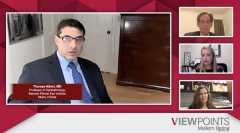
Personal experience with anti-VEGF agents for wet AMD
Episodes in this series

Caroline Baumal, MD: I am sure we all have a wish list of things that we would like to achieve when we treat neovascular AMD [age-related macular degeneration]. We have been given this gift of therapies that use anti-VEGF agents, but now we want to do better. We want our patients to have better vision, and we want our treatments to be safer and more durable. We want to do the best for our patients in a way that is easy for both the patient and for us. Michael, what is your experience with the current intravitreal anti-VEGFs? They all have slightly different dosing intervals. How do you approach that?
Michael Singer, MD: Dosing depends on the patient. There are obviously a lot of factors that are beyond my control when I decide which drug to prescribe. Insurance coverage is obviously an issue, and a lot of companies are now giving us step therapy that we have to go through, such as bevacizumab, and at certain points you may be able to progress to the branded drugs.
Given my preferences, I like prescribing the branded drugs. Although we talked about the studies of CATT, when we look at all the studies where they compare bevacizumab versus branded drugs, essentially branded drugs always dry better. They do not provide better vision, but they dry better. What is interesting to observe is that, if you give the same dosing, that’s how we typically monitor patients in our office [at the University of Texas at San Antonio], is how dry you are on the OCT [optical coherence tomography] because that is an objective measure. That is when I typically extend a patient out. I have seen patients who do very well on ranibizumab, aflibercept, and brolucizumab, and I’ve seen certain people do well on one when I had thought they would do well on the other. Everybody is a little different.
Caroline Baumal, MD: Aleksandra, what’s your experience with intravitreal anti-VEGF agents?
Aleksandra Rachitskaya, MD: I echo what everybody has been saying. We have been really lucky. When patients complain about injections, I tell them about this example. I have a patient who had neovascular AMD in both eyes, and the patient hated injections. She absolutely hated them. She decided that she was going to pick an eye to keep functional. It was so hard for me to do that, but we met with the whole family. It was a whole ordeal, and this patient and I have a natural history. Now, one treated eye is staying 20/30, and we also have to consider the other eye for which she refused treatment. It’s been so dramatic to see how fast she lost vision in that eye.
We have been extremely lucky with the treatments that we have. The newer technologies that you have alluded to hopefully will address the biggest unmet need, which is the injection burden, right? The problem we must address is the number of injections and how frequently patients require them. If we can address that through new injectables, such as combination therapies and something that decreases the frequency of injections, like core delivery systems or gene therapy, we could see real improvement in our quality of care. There are so many exciting things that are happening. Whenever patients mention the injection fatigue, I say, (a) you’re doing great, and without the injections we wouldn’t be talking, so I’m so glad you’re seeing well, and (b) there’s always hope. I try to stress that to my patients as well.
Caroline Baumal, MD: That is great. That is the way to do it. Tom, let me ask you a quick question. You have a patient, they are on treat and extend, and you have got them at 3 months. You have treated them every 12 weeks or 3 months, and they’ve been stable. Do you ever stop injecting these patients? What is your scientific reason to continue this forever? How do you feel about that?
Thomas Albini, MD: I do not have great data to guide me on when to stop treatment. My experience with that dilemma is that I remember a time when, back in 2005 or 2006, when we started with Avastin, and ranibizumab was FDA approved, people were saying never extend out past 3 months. I had a patient like this, who was not injected for 6 months or 8 months, and then that patient came back to us with a massive submacular hemorrhage. Now, that experience got me into that habit of not extending patients beyond a certain point, and that number has increased over time. It was 3 months, then it was 6 months.
But I still tend to feel uncomfortable about extending people out to fewer injections than 1 per year. I’ll still try to sneak 1 in and convince the patient to receive 1 injection, even if they’re perfectly flat. That is something that is tailored to the patient, however, because I do not yet have great science to guide me about when to stop. My suspicion is that it is OK to stop and that some small number of patients are going to have submacular hemorrhages, but I do not know if that 1 injection every 6 months or every year really makes a difference. I may just be treating my own nerves when doing that. I’d be interested in what other people do, but that’s honestly the way I look at it.
Caroline Baumal, MD: When I start to see a little bit of atrophy, or if the patient has been dry for a long time and I see nothing on the OCTA [optical coherence tomography angiography], I will stop treating. It is a big discussion. We have to discuss these complex issues with patients who we might see only for brief periods, especially now it may be even more brief because our patients do not want to be in the office very long. We do need some guidance from studies on when to stop treatment.
Newsletter
Keep your retina practice on the forefront—subscribe for expert analysis and emerging trends in retinal disease management.


















































